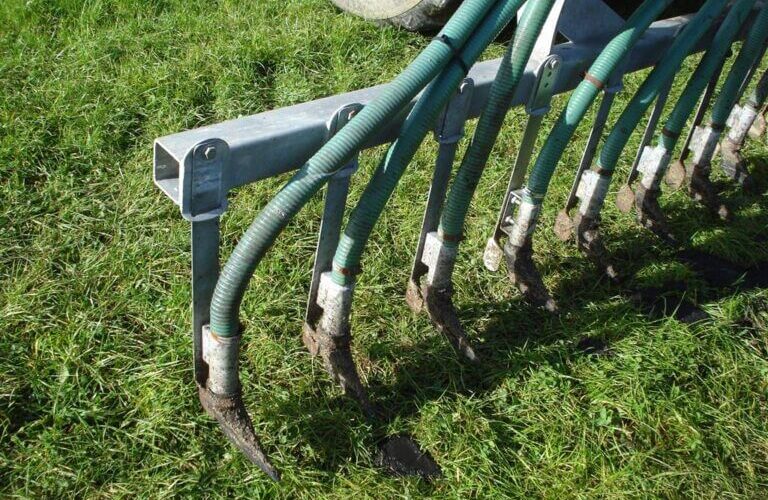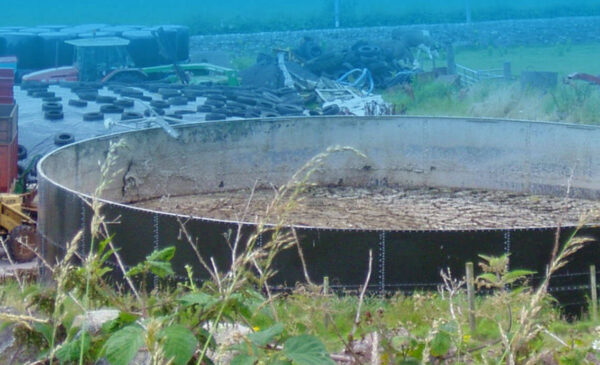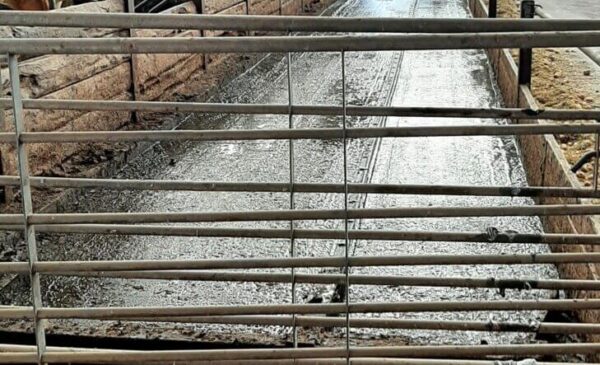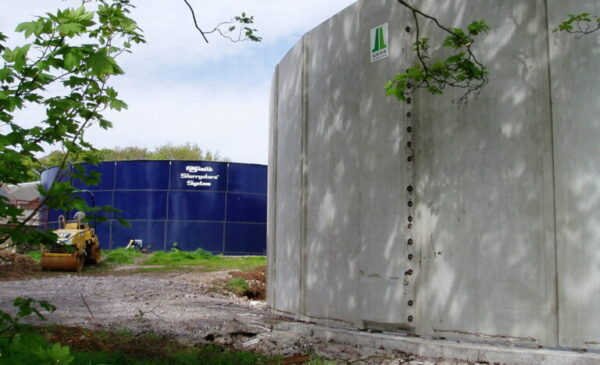Recycling slurry and manure back to agricultural land, when done correctly, can provide a valuable source of organic matter and crop nutrients back to the growing crop. Applying at the wrong time, in poor weather conditions or at a time when there is no demand from the growing crop risks nutrient losses to the environment, can lead to air pollution and is also a financial loss to the business.
It is generally good practice to apply slurry under cool and damp conditions and use Low Emission Slurry Spreading (LESS) techniques (also referred to as precision application), which minimise the contact of the slurry with the air, such as dribble bar, trailing hose, trailing shoe, or injection to further reduce emissions. The use of high trajectory splash plates and rain guns for applying slurry is no longer permitted; smaller farms have until January 2027 to move away from an inverted splash plate to use precision slurry application techniques.
All farms applying organic manures to land must have a RAMS (Risk Assessment for Manure and Slurry) land plan. The person applying the organic manures also needs to have sight of and follow the RAMS plan.
Further information
- Read the Know The Rules factsheet 8 – Organic Fertiliser.
- Draw up a RAMS land plan – the Know the Rules factsheet 9 RAMS land plan explains how.
- Watch how one contractor has moved away from splash plate application to precision application of slurry.
The timing of slurry application to land has consequences for the risk of nitrogen loss by leaching. Times of high leaching risk include:
- Periods of excess rainfall (when rainfall exceeds evaporation).
- When there is soil drainage occurring (i.e. when the soil is saturated, at ‘field capacity’).
- When there is low crop nutrient demand.
Therefore, when applying organic fertiliser, you must not:
- Apply during heavy rainfall or if heavy rain is forecast within 24 hours.
- Apply to land that is:
- within 10 m of any surface water, wetland or shoreline.
- within 50 m of any spring that supplies water for human consumption or any uncapped well or borehole.
- Frozen (unless its farmyard manure (FYM) outside an NVZ).
- Snow covered.
- Sloping, unless a sufficient buffer is provided to intercept any run-off to prevent slurry/contaminated run-off reaching a surface water, or
- has an average soil depth of less than 40 cm over gravel or fissured rock.
Full account should be taken of the weather, particularly during periods of prolonged wet weather, prior to any organic fertiliser applications.
Rainfall readily washes nitrate from the soil profile. There is a high risk of water pollution from nitrate losses if livestock manures and slurries are applied when crop uptake is low or non-existent (i.e. in the autumn or winter period). Aside from the potential loss of nutrients, the impact of trafficking on soil structure and field conditions should be noted.
Farmers and land managers will know which fields are lower risk in terms of runoff and adequate buffer distances should be put in place next to watercourses; this will be demonstrated in the farm RAMS (Risk Assessment for Manure and Slurry) plan. Even a field that is normally suitable for slurry application and is a low pollution risk could become unsuitable and a high pollution risk following heavy rainfall.
Further Information
- Read the Know The Rules factsheet 8 – Organic Fertiliser and factsheet 9 to draw up your own RAMS land plan.

Low emission slurry spreading (LESS), also referred to as precision application techniques, can reduce ammonia emissions compared to broadcast application because it reduces the exposure of ammonia in slurry to air. Estimates suggest that when combined with the correct timing, precision application can decrease ammonia emissions to air by up to 30% to 70% compared with splash plate application.
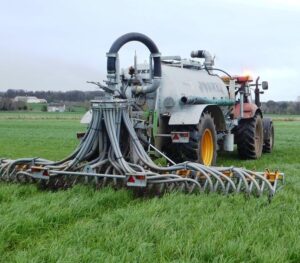
A conventional splash plate will broadcast slurry across the grass surface. Using trailing shoe or dribble bar or umbilical system with a dribble bar will place the slurry in bands or lines on the ground, giving a number of benefits in terms of slurry placement, preserving more nutrients for the growing crop and shortening livestock return times.
Raised /high trajectory splash plates or rain guns can no longer be used to apply slurry. Farms with 100 or less milking cows, 200 beef livestock units or 800 fattening pigs or sows must apply slurry using precision equipment from 1 January 2027. Both contractors and farmers, which exceed these thresholds must not use splash plates as a method of applying slurry and should have already made the switch to precision application techniques.
There is a range of different slurry spreading equipment that can help you move towards precision slurry application or LESS (Low Emission Slurry Spreading) techniques. Table 1.6 outlines some of the options. Although there is no one-size-fits-all method, the main consideration around these systems is in consistency of slurry and pumpability.
Table 1.6 Slurry precision application techniques
| Equipment | Operation | Points to note |
| Dribble bar/Band spreader | Slurry added through flexible pipes placed above the crop to deposit slurry in lines. | Most simple system of the precision application techniques.
Can be used on grass and arable crops. Suitable for hilly ground. |
| Trailing Shoe | Adaptation of the band-spreader. Each pipe has a ‘‘shoe’’ coulter attached at the base of the pipe, which separates the sward canopy to apply slurry at the soil surface. | Well suited to grassland applications.
Sward contamination risk reduced. Can apply to taller grass swards with minimal effects on grass quality. |
| Injection systems(shallow to 50 mm depth; deep to 150 mm depth) | Uses discs that cut slits into the soil. Slurry is added into the slits. | This is the best method to reduce ammonia losses with less slurry exposure.
May not be suitable for all soils due to the variability of soil texture, stone content and topography. Requires greater tractor power to pull the injection unit through the soil. |
| Umbilical application systems | Although not a precision application technique in itself, its often used in combination with the above systems.
One tractor operates a pump at the slurry storage tank, sending slurry via a flexible pipe to an application unit (operated by a second tractor) in the field. |
Reduce soil compaction risks as heavy slurry tankers are kept out of the field.
Slurry can be pumped to distances of up to 1 km or more. Limited by pipe length; can lead to ‘over application’ at sites closer to the steading. |
Further information
- Download a Free nutrient budgeting tool.
- Read the FAS Technical Note on optimising application of livestock manures TN 736.
- Read findings from Teagasc around low emission slurry spreading equipment.
The quantity of liquid slurry that can be applied to an area without causing surface run-off is dependent on soil type and conditions including structure, moisture content, infiltration rate and surface gradient. As the permeability and infiltration rate of a soil decrease and the surface gradient increases, the risk of surface run off is increased. To minimise this risk, liquid slurry must not be applied at rates greater than the infiltration capacity of the soil and at no time during periods when a soil is waterlogged, snow covered or frozen. This applies to both surface application and soil injection methods.
As a guide, a standard application rate of 25-30 m3/ha is generally used, with crop nutrient requirements met through additional slurry applications. Repeat applications should not be made for a period of at least three weeks, so as the crop can utilise the available nutrients.
Livestock should be kept out of fields during and immediately following slurry applications with a no-graze period of two weeks after using low emission spreading techniques. Guidance was previously six weeks following splash plate applications.
The use of heavy, fully laden tankers in wet conditions increases the risk of soil compaction and damage, which will reduce the infiltration capacity of the soil and increase the potential for run-off.
Spreading slurries and manures at a time when conditions are not ideal also costs money later, in terms of remedial works to overcome compaction/tracking and the associated crop yield reduction or reseeding requirement. A workable application rate would be an application rate of 25-30 m3/ha.
Further information
- Read the FAS Technical Note on optimising application of livestock manures TN 736.
- Read findings from Teagasc around low emission slurry spreading equipment.
- Download the Valuing Your Soils brochure for practical information on identifying and remediating soil compaction.
A Risk Assessment for Manure and Slurry (RAMS) must be carried out in respect of any land, which receives organic fertiliser such as slurry, manure or digestate.
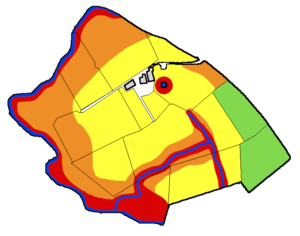
The RAMS map shows no spread, high, medium and low risk areas for application for organic fertilisers and allows you, and those working on your land, to see level of risk associated with land application. The RAMS map must be provided to the person carrying out the application (e.g. contractor, farm worker etc.). Recent changes include marking the location of any field heaps on your RAMS map and including the size of fields on the plan.
Organic manure must be applied in line with crop demand. Note should also be taken of permitted rates within Nitrate Vulnerable Zones, including nutrients deposited from grazing animals.
Further information
- Read the Know the Rules factsheet 9 RAMS land plan.
- See the additional requirements for farmers in Nitrate Vulnerable Zones (NVZs).

